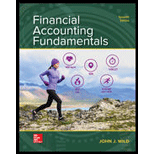
Concept explainers
Inventory:
Inventory refers to the stock or goods which will be sold in the near future and thus is an asset for the company. It comprises of the raw materials which are yet to be processed, the stock which is still going through the process of production and it also includes completed products that are ready for sale. Thus inventory is the biggest and the important source of income and profit for the business.
First In First Out:
In case of First in, first out method, also known as FIFO method, the inventory which was bought first will also be the first one to be taken out or to be sold.
Last In First Out:
In case of Last in, first out method, also known as LIFO method, the inventory which was bought in the last will be taken out first or to be sold first.
Net Profit Margin:
The revenue or income earned after eliminating costs and charges results to profit margin.
Current ratio depicts the efficiency of the company to offset its short period legal responsibilities through assets.
Full Disclosure Principle:
Full disclosure principle is one of the accounting principles which states that the company should reveal or unfold all the relevant facts and figures especially regarding the accounting policies followed by the entity in preparing financial statements which apparently affects the decisions of the reader’s. Disclosure can be made either through notes or schedules.
Consistency Principle:
Consistency principle states that a company should adhere to the once adopted policies, principles, methods and rules uniformly or consistently in the subsequent accounting periods until and unless the required change in the policy has a justified reason.
1.
To identify: The way FIFO improves net profit margin and current ratio.
2.
To identify: Change in the method being ethical or not.
Want to see the full answer?
Check out a sample textbook solution
Chapter 5 Solutions
FINANCIAL ACCT.FUND.(LOOSELEAF)
- Please help me solve this financial accounting question using the right financial principles.arrow_forwardI am looking for the most effective method for solving this financial accounting problem.arrow_forwardCan you help me solve this financial accounting question using the correct financial procedures?arrow_forward
- Can you solve this general accounting question with accurate accounting calculations?arrow_forwardI am searching for the accurate solution to this financial accounting problem with the right approach.arrow_forwardPlease provide the answer to this general accounting question using the right approach.arrow_forward
- I need help with this general accounting question using the proper accounting approach.arrow_forwardCan you help me solve this general accounting question using the correct accounting procedures?arrow_forwardVuitton Manufacturing uses a predetermined overhead rate of $38 per machine hour. Estimated machine hours at the beginning of the year were 22,000 and actual machine hours at the end of the year were 23,200. Estimated total manufacturing overhead costs at the beginning of the year are $836,000 and actual total manufacturing overhead costs at the end of the year are $865,000. What is the amount of manufacturing overhead that would have been applied to all jobs during the year?arrow_forward
 Financial AccountingAccountingISBN:9781337272124Author:Carl Warren, James M. Reeve, Jonathan DuchacPublisher:Cengage Learning
Financial AccountingAccountingISBN:9781337272124Author:Carl Warren, James M. Reeve, Jonathan DuchacPublisher:Cengage Learning Managerial Accounting: The Cornerstone of Busines...AccountingISBN:9781337115773Author:Maryanne M. Mowen, Don R. Hansen, Dan L. HeitgerPublisher:Cengage Learning
Managerial Accounting: The Cornerstone of Busines...AccountingISBN:9781337115773Author:Maryanne M. Mowen, Don R. Hansen, Dan L. HeitgerPublisher:Cengage Learning Managerial AccountingAccountingISBN:9781337912020Author:Carl Warren, Ph.d. Cma William B. TaylerPublisher:South-Western College Pub
Managerial AccountingAccountingISBN:9781337912020Author:Carl Warren, Ph.d. Cma William B. TaylerPublisher:South-Western College Pub


